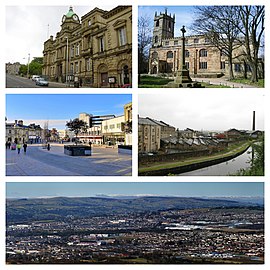| Burnley | |
|---|---|
| Town | |
 Clockwise from top left: Burnley Town Hall; St Peter's Church; Belle Vue Mill; View of eastern Burnley and the Forest of Pendle; St James's Street in the town centre | |
Location within Lancashire | |
| Area | 15.82 km2 (6.11 sq mi) [1] |
| Population | 78,266 (2021 Census) |
| • Density | 4,947/km2 (12,810/sq mi) |
| OS grid reference | SD836326 |
| • London | 181 mi (291 km) SSE |
| District | |
| Shire county | |
| Region | |
| Country | England |
| Sovereign state | United Kingdom |
| Post town | BURNLEY |
| Postcode district | BB10-BB12 |
| Dialling code | 01282 |
| Police | Lancashire |
| Fire | Lancashire |
| Ambulance | North West |
| UK Parliament | |
| Website | burnley |
Burnley (/ˈbɜːrnli/) is a town and the administrative centre of the wider Borough of Burnley in Lancashire, England, with a 2021 population of 78,266.[2] It is 21 miles (34 km) north of Manchester and 20 miles (32 km) east of Preston, at the confluence of the River Calder and River Brun.
The town is located near the countryside to the south and east, with the towns of Padiham and Brierfield to the west and north respectively. It has a reputation as a regional centre of excellence for the manufacturing and aerospace industries.
The town began to develop in the early medieval period as a number of farming hamlets surrounded by manor houses and royal forests, and has held a market for more than 700 years. During the Industrial Revolution it became one of Lancashire's most prominent mill towns; at its peak, it was one of the world's largest producers of cotton cloth and a major centre of engineering.
Burnley has retained a strong manufacturing sector, and has strong economic links with the cities of Manchester and Leeds, as well as neighbouring towns along the M65 corridor. In 2013, in recognition of its success, it received an Enterprising Britain award from the UK Government as the Most Enterprising Area in the UK.[3] For the first time in more than 50 years, a direct train service now operates between the town's Manchester Road railway station and Manchester's Victoria station and onward to Wigan Wallgate via the restored Todmorden Curve, which opened in May 2015.
- ^ Cite error: The named reference
2001urbanwas invoked but never defined (see the help page). - ^ "Burnley – local data profile" (PDF). gov.uk. March 2024. Retrieved 4 August 2024.
- ^ "Burnley named most enterprising place in Britain". Gov.uk. Retrieved 11 June 2022.


